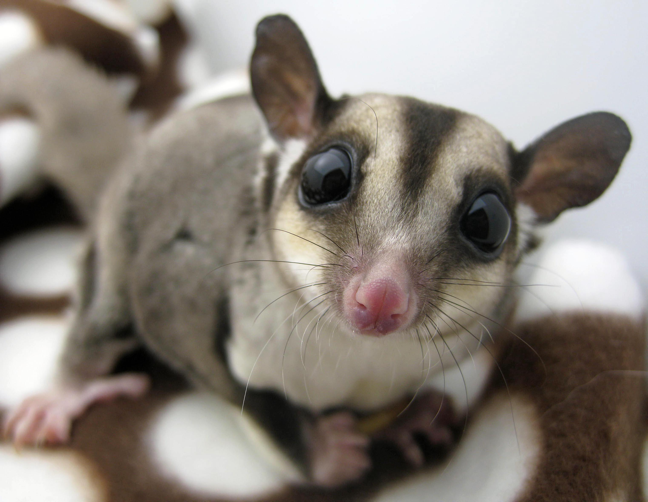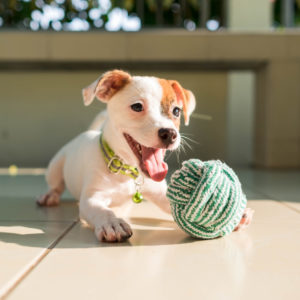Sugar gliders are very unique animals that many people in the general public don’t even know exist. Over the past 15 years, they have been domesticated and are now known to make great little pets! If you are interested in bringing a sugar glider into your home, here is what you need to know.ABOUT SUGAR GLIDERS
Sugar gliders are native to places like Australia and Indonesia. They are not rodents as some would assume, but are marsupials, meaning they raise their young in a pouch on the mother’s belly, similar to a kangaroo. They are nocturnal animals which means that they sleep through the day and are awake and active at night.
Sugar gliders get their name from the fact that they love eating sweet, sugary foods (especially fruits and vegetables) and that they have a thin membrane that stretches from their wrists to their ankles, much like a flying squirrel, that allows them to jump and glide through the air. In the wild, they can glide from tree to tree at a distance of up to 150 feet!
Adult sugar gliders weigh between 4-5 ounces and usually measure around 12 inches from nose to the tip of the tail. The tail is responsible for at least half of its length. These creatures are quite vocal and can bark somewhat like a small dog. When cared for properly, they can live in captivity up to 15 years.
Because they naturally live in colonies of 10-15 other sugar gliders, they are considered social animals and usually do better in homes if they are in pairs. This is also why they have the instinct to bond with an entire group and tend to do very well in a family setting, including with children and other pets. They usually end up having a favorite person in the family that they bond the strongest with, most commonly whoever handles them the most.
DIET
In general, 75% of a sugar glider’s diet should consist of a variety of fruits and vegetables and 25% should be protein. As previously mentioned, they tend to prefer sweet fruits and veggies. They also very much like treats included in their diet! Here are some examples of appropriate fruits, vegetables, proteins and treats you can feed your sugar glider:
Fruits & Vegetables: apples, apricots, avocados, bananas, berries, cantaloupe, carrots, cherries, sweet corn, dates, figs, grapes, grapefruit, honeydew, mangoes, oranges, papaya, peaches (*NOT the pits – toxic!), pears, pineapples, sweet potatoes, plums & raisins.
Proteins: meats (small pieces of cooked lean cuts of turkey, chicken, etc. with no added spices or sauces), hard boiled eggs, yogurt, cottage cheese, tofu & peanut butter.
Treats: live insects (crickets, mealworms, earthworms, etc; high in fat and should only be given as treats and not a main part of the diet; **don’t feed insects you collect from outside – may be contaminated with pesticides) & raw and unsalted nuts
Sugar gliders can be picky eaters so they don’t always get all of the nutrients they need. Because of this, it is recommended to add supplements, such as a reptile multivitamin or a calcium supplement with D3, to their diet.
You should always have fresh water available to your sugar glider, however they get most of their water intake from their food so don’t be alarmed if they are drinking very little.
Some sugar glider owners feed their pet once a day at dusk and some twice a day, morning and night. This really depends on your sugar glider’s preference. If they seem hungry again in the morning, you can try giving them a small amount of food in the morning or giving more food in the evening.
*** Sugar gliders should NEVER be fed raw sugar, sugar substitutes, candy, or chocolate!
HABITAT
A sugar glider’s cage should be as large as possible, the taller the better. They need a lot of room to climb. For one sugar glider, the recommended size is 20″ x 20″ x 30″. The cage should have wire mesh or metal bars, and they should be close enough together that your tiny glider can’t squeeze through. Their habitat should also be in an area that is not busy in the daytime so that they can sleep. Avoid direct sunlight, but make sure there is enough light in the room to distinguish between night and day. The room should ideally be 15-30 degrees Celsius.
Sugar gliders like to eat up high so food dishes that attach to the side of the cage are best. They also need some sort of nesting area to sleep in during the day. Examples of this include a cloth pouch, a wooden birdhouse, a plastic hamster house, etc. There should be bedding at the bottom of the cage to absorb urine and droppings. You can buy suitable commercial bedding or you can use wood shavings or shredded paper. Whatever you use should be non-toxic in case it is ingested.
Sugar gliders love toys so you should provide them with as many as possible, such as bird toys, chew toys, ladders, bells, exercise wheels, tunnels and balls. You can also add some branches to the cage so they have more to climb on, but be sure they are made from non-toxic wood and that they are replaced regularly as they become soiled.
HEALTH
Some may think a small pocket pet like a sugar glider won’t need to ever go to the vet for a check-up, however there are many potential medical issues a sugar glider can be faced with, including:
Calcium deficiency: If your sugar glider does not have a calcium-rich diet, they will show symptoms of lameness, paralysis and difficulty moving. If you think your sugar glider is not receiving enough calcium, you should consider adding in calcium supplements to prevent these symptoms.
Constipation & diarrhea: If the diet does not contain enough roughage, you may see a hard, distended stomach, difficulty defecation and hard dry stools. On the other hand, if your sugar glider is stressed, eats too much citrus fruit, or many other causes, you may see diarrhea. Diarrhea is dangerous because sugar gliders can quickly become fatally dehydrated if not treated.
Injury: This one is pretty obvious, but common sugar glider injuries include torn claws, open wounds, and broken bones.
Parasites: Sugar gliders can get parasites just like a cat or dog, such as ticks, fleas, mites, lice, roundworm, hookworm, tapeworm, etc. If you suspect your sugar glider has a parasite, ask you veterinarian for treatment options.
Stress: Sugar gliders can get stressed from a poor diet, an illness, a dirty cage, a cage that is too small or overcrowded, overhandling, loneliness, boredom, excessive heat or cold, and plenty of other possible reasons. Signs that your glider is stressed include loss of appetite, excessive eating, excessive sleeping, and frantically circling the cage.
Written by Stephanie, RVT




